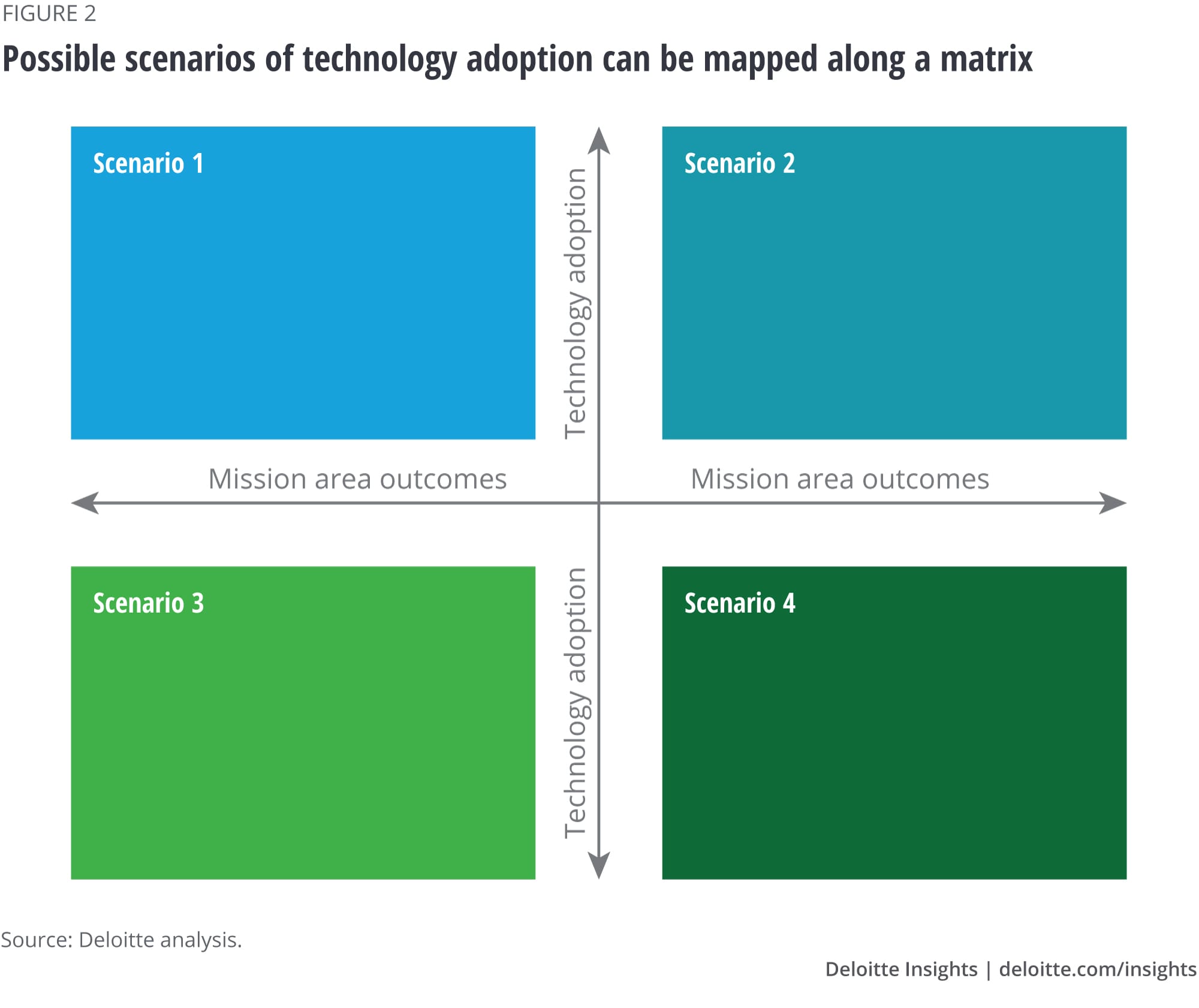
Push innovation in government How to change emerging technology’s potential from disruptive to transformative
9 minute read
20 April 2019
 RJ Krawiec United States
RJ Krawiec United States Alan Holden United States
Alan Holden United States Joshua Schoop United States
Joshua Schoop United States Shabab F. Hussain United States
Shabab F. Hussain United States
As government grapples with new technologies, how can leaders prioritize which technologies to select and deploy? One approach is to start with the solution, not the problem, using push innovation.
From robot-operated hamburger stands, to your face replacing a paper ticket as your boarding pass, emerging technologies are transforming nearly every aspect of how we live, work, and connect with each other. But they can present new threats as well. One has to look no further than the 2018 cancellation of a thousand flights at Gatwick Airport near London due to drone sightings1 to see just how quickly new technologies present new challenges.
Learn More
Read more from the Government and public services collection
Explore the Innovation in government collection
Subscribe to receive related content from Deloitte Insights
Government leaders know that these types of technologies will likely impact their mission areas, and that it’s important to stay ahead of the curve. But they don’t always have a clearly defined use case for a new technology or a pain point that the technology can solve. In cases like these, how can government leaders prioritize which emerging technologies warrant the use of their often-limited resources? And how can they then apply the selected technology—whether artificial intelligence (AI), blockchain, or augmented reality (AR)—across the enterprise in a meaningful way?
Push innovation refers to the introduction and development of a new technology or product primarily due to technical and scientific advances, rather than as a response to defined challenges and user needs.
While many traditional approaches to innovation begin with the problem you are trying to solve, “push” innovation starts with a new solution or technology and then identifies the problems it can be applied to. Potential benefits of push innovation for government can include:
- Lower risk associated with upfront cost of new technologies. Rather than investing in R&D associated with new technologies that may never pan out, a disciplined approach to push innovation can allow government organizations to capitalize on the benefits of new solutions without relying on trial and error.
- Leapfrogging short-lived technologies. Push innovation can allow government organizations to avoid investing in more incremental solutions which—given the often difficult and long time horizon sometimes associated with government procurement—may be obsolete by the time they are implemented.
- Reframing public sector challenges through a new lens. Push approaches rely on the use of parallel use cases and analogies from startups and industry to help government organizations identify opportunities for innovation they may never have known existed.
- Anticipating new opportunities and threats before they become mission-critical. A disciplined approach to push innovation forces government organizations to consider how emerging technologies can impact their mission, allowing them to be proactive rather than reactive in taking advantage of the opportunities and mitigating the threats they represent.
Companies frequently develop new solutions through push-based approaches, ranging from the component-driven innovation commonly used to develop new consumer products, to technology companies’ R&D investments in capabilities such as AI.2 In these cases, user applicability and demand are often only considered after a new concept has been developed.
Government’s tendency to move slower in innovation adoption than the private sector can be beneficial when it comes to push innovation, as it can allow the public sector to leapfrog generational technology and infrastructure. Perhaps the most commonly cited example of this is how some countries in the developing world have leveraged advances in cellular technology to skip costly infrastructure investments of landline-based communications and have gone straight to a mobile communications network.3 Similarly, governments can learn from proven private sector uses for new solutions, reducing the risk and avoiding the costs associated with exploratory testing.
Ultimately, by utilizing “push” techniques to augment traditional innovation strategies, government organizations can not only keep abreast of emerging approaches and technologies but also determine where and how to apply them for maximum impact.
A framework for effective push innovation
Making push innovation successful in the public sector requires a disciplined approach involving a diverse group of stakeholders. Our review of practices for push innovation reveals seven key steps that can allow an organization to stay ahead of the curve, identify new disruptive technologies, and apply those technologies to its mission space (figure 1).

Sensing, scouting, and scanning
Push innovation efforts generally begin with divergent thinking—aka, casting a wide net to identify new technologies or solutions that may have previously been unknown. Sensing, scouting, and scanning efforts are digital-, research-, or network-driven activities to identify emerging technologies or trends that could be relevant to an organization’s issues.
Organizations that utilize these approaches often begin by selecting a mission priority they wish to focus on and then systematically analyzing information and trends to identify five to 15 factors likely to impact that priority. These factors should include both external forces as well as specific technologies.
The United Kingdom’s Horizon Scanning Programme recommends a framework that includes a broad analysis of societal, technological, economic, environmental, political, legal, and ethical areas.4 In the United States, the Department of Homeland Security Science and Technology directorate set up an office to provide technology scouting services, to which other government programs can submit scouting and scanning inquiries.5
Use case identification
For emerging technologies identified through horizon scanning or some other process, the next step in the push innovation process typically involves identifying as many use cases for them within the organization’s potential as possible. This generally involves looking both externally, to identify where and how the technology/solution is being applied in other industries and sectors, and internally, to determine additional applications of the solution that may not be prevalent in other sectors but could still be relevant for the organization.
While finding potential public sector use cases for a given technology may appear daunting, resources do exist. For example, in October 2017, the General Services Administration’s Emerging Citizen Technology Office launched the Emerging Citizen Technology Atlas, an open-source repository of federal use cases for emerging technologies such as blockchain, AI, and AR.6
Partnering with startups
To identify use cases of emerging technologies in other industries, one of the most effective strategies involves engaging startups. Startups and entrepreneurs by their nature sit at the edges of innovation, hoping to be that next big thing. By looking to engage startups as part of their strategy, public sector innovators can quickly bring new, disruptive technologies to life inside their organization.
Startups and innovative small businesses can have at least two overarching benefits: They can offer government agencies valuable new ways of solving longstanding problems, and they can provide cost-effective alternatives to larger, more well-established companies. As budgetary constraints continue to reduce available resources, new, innovative contracting models that increase accessibility to these entrepreneurs and reduce the complexity and cost of doing business with the government are increasingly needed.
The US federal intelligence community has recognized the value of engaging startups and taken a substantial step in formalizing its relationship with them. In 1999, leaders at the Central Intelligence Agency founded In-Q-Tel, a nonprofit venture capital group that identifies, invests in, and advises startups with the potential for high impact on national security. While many of its investments are not disclosed due to their relation to national security, In-Q-Tel currently features more than 200 of its investments on its website, and a 2012 study concluded that the average dollar invested by In-Q-Tel attracts nine dollars of investment from other companies.
Scenario planning
Once the technology and potential use cases have been identified, scenario planning allows an organization to articulate the potential futures that could result from the adoption—or lack of adoption—of that technology or solution, using the identified use cases as guidance. This can play a valuable role in helping an organization prioritize which emerging technologies/capabilities should be invested in, given the opportunities and threats they present.
Although there are many approaches to scenario planning, possibly the simplest is using a matrix of technology adoption versus possible outcomes (figure 2). This approach analyzes the interplay between a major mission-focused challenge and an emerging technology to depict the possible futures that could occur.

Scenario planning is not a new practice in the public or private sectors. The National Intelligence Council regularly engages in scenario planning to produce quadrennial assessments of the forces and technologies driving changes across the globe.7 Similarly, the US Army Training and Doctrine Command’s Mad Scientist initiative continually explores the future of national and global security in relation to how disruptive technologies might impact the warfighting environment of the future.8 And Singularity University, a Silicon Valley think tank, enlists science fiction writers to articulate future scenarios of how new technologies could shape the world.9
Technology selection
Based on scenario planning, criteria for selecting which technology or technologies to focus on include, but are not limited to:
- Utility estimates of benefits and threats for each scenario;
- Rough order of magnitude (ROM) estimates for the costs and level of effort associated with adoption of the technology;
- Estimated likelihood of each potential future occurring;
- Projected timeframe for each scenario to occur; and
- Approval authorities and additional requirements for implementing a given solution.
Each organization should make an independent assessment of which potential technologies/approaches to incorporate into their broader innovation efforts, based on their unique organizational priorities. For example, the US Federal Highway Administration provides guidance to cities, municipalities, and other transportation departments on how to use scenario planning to make investment decisions around new transportation planning and infrastructure.10
Business case development
The selection of a given technology/approach is not the same as selecting the specific ways in which an organization can use it for innovation. While the technology selection phase of the push innovation process focuses primarily on assessing the different technology/solutions available to an organization, this phase is designed to focus on helping an organization make specific investment decisions around potential use cases for that technology.
ROM estimates for cost and effort, expected impact, and estimated time horizon for deployment should each be considered for each use case of the technology/solution.
Use case selection
Based on results of the business cases for each application of the technology/solution, a subset of these applications should be selected for development as pilots. If funding exists for multiple pilots, an organization can either select a set of projects that can be managed as a portfolio to balance risk and return, or a group of projects that can be integrated into a broader portfolio of innovation efforts in the same way.11
This approach offsets the risk and longer time horizons of more transformational projects with more immediate returns of less effective and less risky (and more rapidly implemented) efforts. Additionally, taking a portfolio-based approach allows multiple projects to draw on the same infrastructure and can justify architecture investments at the enterprise level. For example, if multiple selected use cases require a cloud-based data storage capability, the organization has both additional justification for investing in this type of infrastructure and can save costs by simultaneously running multiple pilots that utilize the same underlying architecture.
Deployment
Even good ideas often fail when they are tested or scaled ineffectively. The public sector organizations that tend to be most effective at piloting, evaluating, and scaling innovations often combine a structured, data-driven methodology with technology tools.12 Pilots should be continuously reevaluated to see if they are achieving the desired impact, with go/no-go decisions made based on the evaluation criteria used to select the use cases for piloting.
Push innovation in action
What does push innovation look like in action, and what real-life examples prove its value to public sector organizations? The US Customs and Border Protection’s (CBP) exploration of blockchain and the US Department of State’s (DoS) portfolio of AI efforts are two examples that seem to demonstrate why the strategy should be a part of more organizations’ broader innovation strategies.
Case study: Blockchain at the customs and border protection
Blockchain has captured the attention of both the private and public sectors as an emerging technology with far-reaching applicability.13 As a distributed consensus ledger, blockchain creates trust across participants through a collectively agreed-upon consensus protocol. Because blockchain is so new, use cases have not been explored widely across government, which can make it an ideal technology for which to try push innovation.
The CBP is one of several agencies looking to identify and test use cases where blockchain could be leveraged, and the organization’s approach to identifying use cases represents potentially helpful examples in push innovation. To better understand the potential benefits of investing in the technology, the CBP’s Commercial Customs Operations Advisory Committee brought together stakeholders from across Department of Homeland Security to explore blockchain applications in trade processing.14 Participants collaborated in the development of criteria, and identified and prioritized ideas for further evaluation.
The group came up with 14 proposed use cases, including solutions related to capturing and keeping track of partnering government agencies’ licenses, permits, and bonded movement tracking.15 The CBP is now looking to engage the trade community in a conversation on where use of blockchain might or might not be appropriate.
“Really, what the government is trying to do is twofold: help blockchain along in a healthy manner for increasing market adoption and try to prepare ourselves in a proactive way to be ready for when private industry begins to really take off with this technology.”—Vincent Annunziato, business transformation and innovation division director, US Customs and Border Protection16
Case study: AI at the Department of State
The DoS Virtual Student Foreign Service program allows US government agencies to engage US students in US federal government research projects.17 The program is currently exploring various use cases for AI, including:
- Creating an AI chatbot trained on a dataset of press releases and spokesperson statements to answer questions about US foreign policy;
- Exploring the applications of AI in international policy; and
- Benchmarking other nations’ use of quantum, blockchain, gene editing, and AI technologies.18
Like the CBP, the DoS initially had no clear application for AI identified but, instead of bringing experts together, the agency relied on the ingenuity of US students to propose and explore potential applications of the technology.
A potentially powerful approach
With government organizations under pressure to meet mission demands with tight budgets and strong regulatory oversight, adopting emerging technology can be challenging. But failing to adopt these technologies can put these same organizations at risk of struggling to keep up with changing citizen expectations, possibly becoming vulnerable to new threats, and potentially spending more taxpayer dollars to replace redundant or obsolete systems.
Push innovation presents an opportunity for government agencies to instead act as a fast follower of the private sector, leapfrogging the latter’s early explorations to incorporate transformational innovation into the public sector organization’s broader innovation portfolio.
Explore innovation in government and public services
-
Innovation Collection
-
Government cloud: A mission accelerator for future innovation Article5 years ago
-
Developing innovation portfolios for the public sector Article6 years ago
-
Transforming the cost structure of government Article6 years ago
-
Success at scale for governments Article6 years ago
-
Catalyzing public sector innovation Article7 years ago











